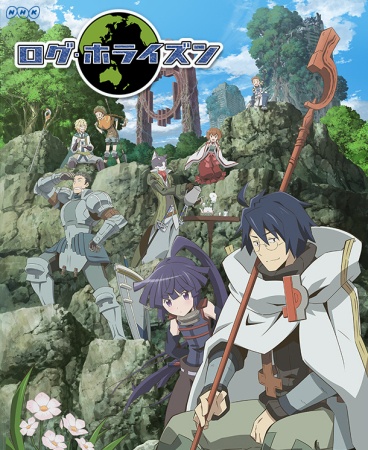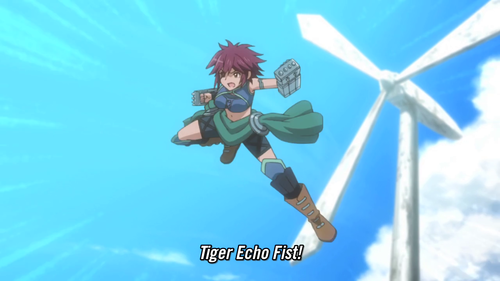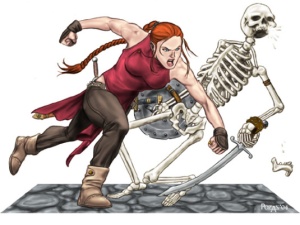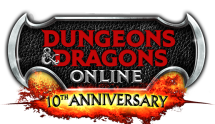 The blog title is not a question for you, good reader.
The blog title is not a question for you, good reader.
I have scoured Hulu for more gaming-themed anime after the (Epic!) conclusions of the second seasons of “Log Horizon” and “Sword Art Online“.
I found a new one. It’s title is…unfortunate, and long, but the storyline more than makes up for it.
“Is It Wrong to Try to Pick Up Girls in a Dungeon?” (hereafter called “Dungeon”, known by fans by the nickname of “DanMachi”) is the story of a newb. Yes, that inexperienced adventurer that’s certainly going to die in the first few minutes of a quest from grave inexperience, or so you think.
The world of “Dungeon” involves a large town where a massive ancient multifloored dungeon rests below. Many adventurers carefully explore the tower and whoop any monsters found. Monsters continually spawn, so were it not for the adventurers, the monsters would rise up and overwhelm the world. The side-benefit for the world of Orario is that adventuring is a primary occupation.
This world isn’t a game come to life like Log Horizon or a virtual MMO as is Sword Art Online, but uses some gaming principles and mechanics in a “real life” in-universe context, specifically stats. On the literal backs of every adventurer is an elaborate magical tattoo that basically show the adventurer’s stats, skills and magic, if any.
There are gods, too. Quite a few. They aren’t watching over their world from another plane of existence, deciding what fate to give to their “children,” as they call the humans, elves, dwarfs, and others. Eons ago, as the story goes, they got bored. Collectively, they sealed off most of their divine powers and incarnated themselves to live and learn with their children, including taking on both pleasures and inconveniences of bodily form.
What powers they did keep were given to the adventurers to help develop and raise their skills to fight monsters. The gods form guild-like families, or familia, each of which often specialize in something. Magic. Blacksmithing. Drinking. Each god in the familia is responsible for reading changes to their children’s stats by reading their back and mystically manipulating the information there.
Our hero, Bell, decided to become an adventurer after his grandfather was killed. But he knew enough that he would get killed without joining a familia. But he was rejected by everyone until a lone goddess named Hestia offered him a place with her. Bell is generally a lightly armored rogue-like fighter, using (for a time) only a small dagger or short sword.
So now the Hestia Familia is active, membership: 2. Some familia are rich and live in good homes, even mansions. Hestia isn’t there yet. Bell and Hestia live in the basement of a long abandoned church. Their furniture is ragged and there is only one bed, where Bell, being a gentleman, gives to Hestia, while he sleeps on the couch.
“Dungeon” is filled with familiar characters or roles that they play in adventurer business. There’s a business that advises adventurers, dressed in business attire and who also serve as the government in terms of rules that adventurers must obey outside of the dungeon. That group also exchanges the monster crystals (what’s left of a monster after they are destroyed) in exchange for the currency.
Like DDO’s guilds, familias come in many sizes and leadership. A few are rotten, most are good, some are small and others very large. An adventurer can form a party from members of other familias, but otherwise are discouraged within their own ranks from trying to fraternize too strongly.
 Bell’s life changes at the very start of episode 1. This white-haired kid is on a low dungeon level when a minotaur from several floors up goes on a rampage and nearly turns Bell into goo where it not for Ais, a stunningly beautiful blonde and highly powerful adventurer. She’s a level 6 adventurer, perhaps the equivalent of a DDO level 18 character, which took her 10 years to reach.
Bell’s life changes at the very start of episode 1. This white-haired kid is on a low dungeon level when a minotaur from several floors up goes on a rampage and nearly turns Bell into goo where it not for Ais, a stunningly beautiful blonde and highly powerful adventurer. She’s a level 6 adventurer, perhaps the equivalent of a DDO level 18 character, which took her 10 years to reach.
Leveling up is normally a very slow process. Bell is a level 1 (as are many adventurers there) and, if he levels like other adventurers, won’t see level 2 before adulthood. But Bell isn’t like all the others.
Bell is amazed at Ais but, often, he’s way too embarrassed to approach her. Bell’s pretty shy all around, which isn’t helped by the fact that his dungeon advisor, a couple of waitresses, and even Hestia herself are rather attracted to him.
“Dungeon” isn’t the typical “harem” anime series, however. Conflict and drama abound. Some adventurers take horrible advantage of small people called “Parum” (it’s Latin for “little”, which avoids getting sued by the Tolkien estate), abusing and stealing what they can from them. And one person, a goddess herself, seems to throw all kinds of bad things at Bell, just to entertain herself as some gods once did in their glory days.
Bell’s growth is reflected by the reactions of other adventurers who are first skeptical then astonished at how he becomes less of the blood-stained “Tomato Guy” that Ais saved to an resourceful adventurer ready to save himself and others if he can do so. While the world of Orario has Clerics, death is final here; there’s no resurrection.
“Dungeon” has mild fanservice (Gainaxing, revealing clothing, Bell often put through marshmallow hell) but no nudity and a little cursing. Despite the harem theme, the show does keep the overt sexuality down, although there are obvious indications that one goddess digs other ladies. It’s believable that many of the girls in the show like Bell. What’s different about each motivation comes from the plot.
The show is sufficiently bloody, however, often involving great moments of awesomeness when Bell does what others believe is completely impossible for him to do.
Unlike SAO or LH, this appears to be a 12-episode series, extracted from its light novel origins.
You can enjoy “Dungeon” completely free on the Crunchyroll movie site, or pick it up with delayed episodes on Hulu Plus.
Bonus points to the producers of the show in using the same voice actor of SAO’s Kirito. That man makes for dramatic voice acting, even if I can’t understand a word he’s saying.













Mea Culpa, Mea Maxima Culpa
19 Apr 2014 10 Comments
by teachersyn in Gameplay, Off-Topic, Personal Stuff Tags: Book of Syncletica, Commentary, DDO, ddo forums, Errors, Pride, Respect
Both guide and blog contain a lot of my experience, sure, but it’s also experience from other players as discussed in the DDO forums, player videos, observed gameplay, the DDO Wiki, and comments from blog posts.
But none of that assures or guarantees that anything written is completely accurate, although I strive for this.
The need for accuracy is obvious. A game is a simulation. If the variables (say, the length of the Death Ward buff from the Visor of the Flesh Render Guards) are described in error (the buff lasts 10 minutes), then you, the player, honestly reading something as a resource, will be disappointed to find that the buff is only 7 minutes.
The Monk guide has been around for about 2 years now in its present form. I had written a private guide from my guildmates over a year before that. Making the guide public meant that I needed to do one thing: swallow any pride in designing it.
If I were prideful in the guide’s usefulness or success, I would see it as a personal accomplishment. In situations like that, such things are then defended, right or wrong.
That’s not why I wrote the guide, or enter posts here.
The guide is meant to be as accurate and concise as I can make it with the limited time and resources I have at hand. If there’s any credit to be given, I accept it only as the editor of what existed out in the game world years before I showed up in most cases.
Despite my intentions, there has and will be times where I screw up information. A recent example came up through a DDO forums post where someone suggested to the devs to increase the XP bonuses for no-kill questing (Discreet, Devious and Insidious Cunning). Most responses argued against the idea (although I thought that Cunning should go from 10 to 15% but never be higher). The subject train derailed a little to how such bonuses are attained and why. I referred to my post that casually contrasted the Rogue Assassin with the Ninja Spy, where I clearly admitted a lot of bias but wanted to be as fair as I could with any data I could sort from the DDO Wiki.
That post came and went–until I reposted the link on this thread.
And not only did a couple site some glaring errors in my comparison (such as Assassins gaining vorpal with sneak attacks at level 18), one poster chose to insult my credibility and make it personal with a disrespectful response I made to another poster to a question asked in another, unrelated thread.
My “Lawful Good” nature is my actual personality. I’ll slay real trolls as quickly as the game versions. I was this close to reporting the post to the forum administrator before I remembered that this is the Easter season, where forgiveness should be greatly emphasized.
Besides, my reaction to the disrespectful comment was probably borderline as well. I barely kept my pride in check.
So what you can get from all that is this: the guide is a public document to me. It’s strength comes from lots of feedback to keep it as accurate as possible. I’m just one of the players, not a Turbine developer and certainly not a subject matter expert or uber player.
Blog entries are less studious and often discuss my reactions, observations and discoveries in gameplay.
Blog entries may also be less accurate because of the more immediate nature of writing them as I desire, rather than due to a need.
I apologize to anyone if anything written here or in guide has not generated the results expected. However, and this is important, I need your comments, criticisms, even complaints, to fix any errors you find. I primarily play one class, and so discussions about other classes might stretch my limits. Just be civil when you respond back. I write and compile all of this out of joy in the game, and I want the work to reflect back to other players to aid them.
The guide will be a poor reference without your feedback. Take the time to help correct me and you’ll have a better reference to use or even recommend to others.
A little update: I think the poster and I are burying the hatchet in that he asked me my viewpoint in a private message. I know he’s a great player but he’s genuinely amazed at my worldview. So I don’t want to make the issue seem too out of hand.